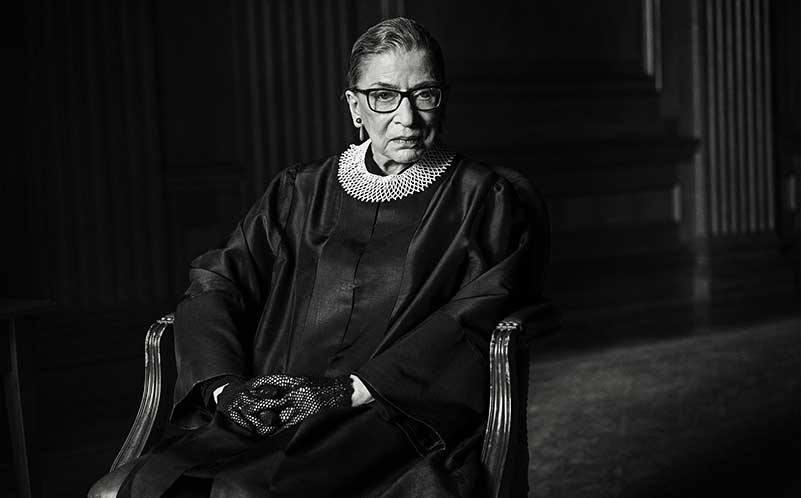by Andre Zendejas
The September 2020 passing of Justice Ruth Bader Ginsburg is one that leaves a broad sense of uncertainty in the realm of environmental law, a realm once occupied by a woman who championed environmental reform amid a sea of opposition.
Ginsburg, best known for spearheading key decisions in gender equality and women’s rights, was the longest serving liberal judge to sit on the Supreme Court. Throughout her 27 years on the court, the core of Ginsburg’s cultural and legal popularity became centered around women’s rights. Yet she also pushed for more comprehensive environmental law.
During her time as a Supreme Court justice, Ginsburg cast her vote on a plethora of environmentally-focused cases. One important case was Massachusetts v. Environmental Protection Agency (2007) in which Ginsburg’s deciding vote bestowed the EPA with the power and authority to regulate greenhouse gas emissions from automobiles.
She also contributed to the landmark decision in Whitman v. American Trucking Associations (2001), which upheld the EPA’s ability to set national air quality standards for smog and soot without consideration for the associated economic costs. This decision helped to preserve the EPA’s ability to address climate issues and set a foundation for future environmental policy.
These cases, along with the many other decisions made in the Supreme Court during Ginsburg’s time as justice, serve as a testament to the emphasis that Ginsburg placed on the wellbeing of the planet and those inhabiting it over the interests of economics and politics.
One cannot undoubtedly say that Ginsburg was always directly invested in environmental protection and regulation. However, her record of these key decisions and her involvement in environmental cases convey her desire to uphold the role of the Supreme Court as she thought it should be: maintaining oversight over regulation and intervening on matters concerning the health and wellbeing of the entire country.
Professor Daniel Farber, the director of the Center for Law, Energy, and the Environment at UC Berkeley, stated that it was Ginsburg’s more “general views of the role that courts should take in overseeing regulation” that allowed for the decisions made during her time on the court.
This commitment to upholding the law and the role of the Supreme Court can be best seen in the opinion authored by Ginsburg over the 2011 case of American Electric Power Company v. Connecticut, which stripped the power of the states to sue private power companies. While one might expect her to side with the states seeking to lower emissions across the country, Ginsburg wrote: “We hold that the Clean Air Act and the EPA actions it authorizes displace any federal common law right to seek abatement of carbon-dioxide emissions from fossil-fuel fired power plants. ”
Despite this unexpected decision from Ginsburg and the rest of the court, her willingness to commit to authoring this opinion displayed her loyalty to the law and how she based her legal decisions off of the nuances of the law itself. Her dedication may not necessarily have been at the expense of environmental progress.
In the court’s opinion, Ginsburg wrote: “It is altogether fitting that Congress designated an ex-pert agency, here, EPA, as best suited to serve as primary regulator of greenhouse gas emissions. The expert agency is surely better equipped to do the job than individual district judges issuing ad hoc, case-by-case injunctions.”
Her vision of the roles that the Supreme Court and EPA play in overseeing regulation have paved the way for the decisions made during her time as a justice. However, the future of environmental law may depend on the restructuring of the court as Ginsburg’s seat was filled.
In October 2020, President Trump successfully nominated Justice Amy Coney Barrett as the ninth seat of the Supreme Court, and the replacement for Ginsburg. The new conservative majority in the Supreme Court has sparked questions over the future of decisions regarding environmental law and policy for the decades to come.
The reputation that conservatives and the Republican Party have garnered in terms of environmental activism and attention elicits the idea that environmental progress made during Ginsburg’s time may be undermined.
“Over the last 20 years, the court has gotten more conservative, and as a result, less receptive to environmental regulation,” Farber said.
Given the trend of growing conservatism already present in the court, the loss of Ginsburg’s occupancy and the confirmation of Justice Barrett to one of the nine seats leaves uncertainty over the question of how the highest court in the nation will recognize and attend to environmental concerns.
However, on the other end of this uncertainty lies the image of a more gradual, yet effective path to climate action and environmental regulation under a conservative court. Despite the recent addition of the conservative Justice Barrett, the Court has witnessed past decisions supported by conservative justices to uphold the ability of environmental agencies and the government to address environmental concerns, such as the Massachusetts v. EPA case.
While this precedent maintains some hope for the future of environmental law in the United States, it is more likely that the environmental progress will be more gradual and periodic.
“It will probably involve, instead of making big dramatic moves, making a larger number of smaller moves that might add up [over time],” said Farber.
The replacement of the ninth seat on the Supreme Court was a process that brought great uncertainty to the nation, whether it be over environmental concerns dealing with large scale matters, or the very livelihood of individual Americans in marginalized communities throughout the fifty states. While Justice Barrett was recently confirmed, it will take time to see the Court’s environmental legacy unfold.
And yet, despite the intricacies and polarization within modern politics, it is Ginsburg’s own words that serve to paint a positive future of environmental law, as well as provide hope for the nation and world as a whole: “Real change, enduring change, happens one step at a time.”

Sources:
https://supreme.justia.com/cases/federal/us/564/410/#tab-opinion-1963617

